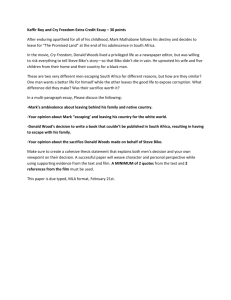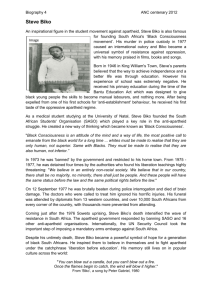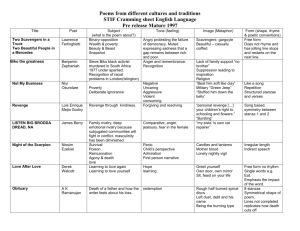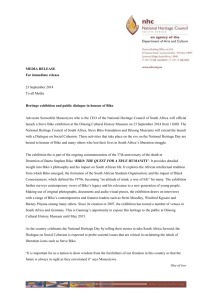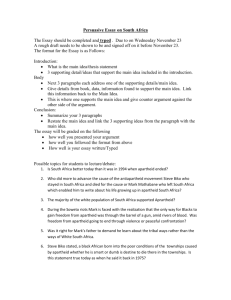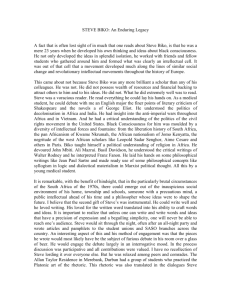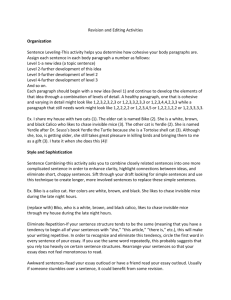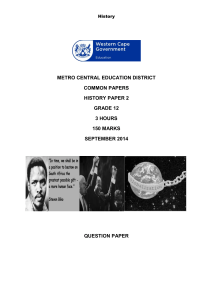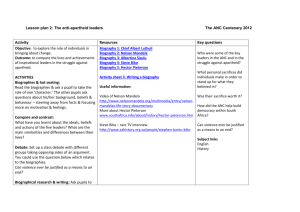Issues in Africa - MrGreensHumanities
advertisement
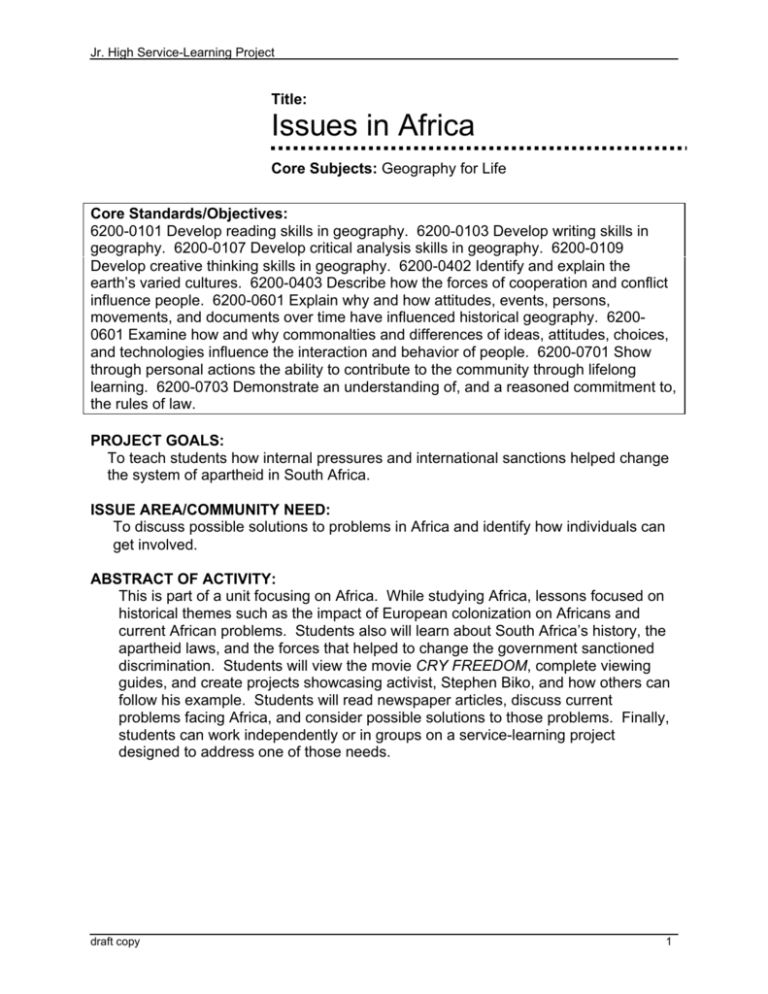
Jr. High Service-Learning Project Title: Issues in Africa Core Subjects: Geography for Life Core Standards/Objectives: 6200-0101 Develop reading skills in geography. 6200-0103 Develop writing skills in geography. 6200-0107 Develop critical analysis skills in geography. 6200-0109 Develop creative thinking skills in geography. 6200-0402 Identify and explain the earth’s varied cultures. 6200-0403 Describe how the forces of cooperation and conflict influence people. 6200-0601 Explain why and how attitudes, events, persons, movements, and documents over time have influenced historical geography. 62000601 Examine how and why commonalties and differences of ideas, attitudes, choices, and technologies influence the interaction and behavior of people. 6200-0701 Show through personal actions the ability to contribute to the community through lifelong learning. 6200-0703 Demonstrate an understanding of, and a reasoned commitment to, the rules of law. PROJECT GOALS: To teach students how internal pressures and international sanctions helped change the system of apartheid in South Africa. ISSUE AREA/COMMUNITY NEED: To discuss possible solutions to problems in Africa and identify how individuals can get involved. ABSTRACT OF ACTIVITY: This is part of a unit focusing on Africa. While studying Africa, lessons focused on historical themes such as the impact of European colonization on Africans and current African problems. Students also will learn about South Africa’s history, the apartheid laws, and the forces that helped to change the government sanctioned discrimination. Students will view the movie CRY FREEDOM, complete viewing guides, and create projects showcasing activist, Stephen Biko, and how others can follow his example. Students will read newspaper articles, discuss current problems facing Africa, and consider possible solutions to those problems. Finally, students can work independently or in groups on a service-learning project designed to address one of those needs. draft copy 1 Jr. High Service-Learning Project TYPE OF SERVICE: Advocacy of issues in Africa. Indirect and direct service could be rendered as an extension of this activity. TIME LINE/TIME COMMITMENT: Two weeks of an overall Africa unit that lasts approximately one month. PREPARATIONS AND MATERIALS NEEDED: Geography textbooks, a copy of the movie CRY FREEDOM (produced by Richard Attenborough, 1987), movie questions, BIKO Illustrated Essay Poster Assignment Guide and rubric, copy of speech given by Nelson Mandela at the Commemoration of the Twentieth Anniversary of Steve Biko’s Death (available online at http://www.anc.org.za/ancdocs/history/mandela/1997/sp970912.html), CD of Peter Gabriel’s song “Biko” on the album Peter Gabriel (#3 aka Melting Peter), and copies of part II (“Boys Dreams of Better Life End in Miserable Death”) and part III (“From the Grave, Boys Plead for End to Africa’s Suffering”) in the Associated Press series “In Case We Die” by Tim Sullivan and Raf Casert, found in THE SALT LAKE TRIBUNE, March 19-21, 2000. Most are included in this lesson plan. PROCEDURE FOR THE PROJECT: 1. Teacher introduces the project by using a pair-square-share activity. Students write about the question “What problems do you think Africa faces today?” Students share responses with a partner, in a small group, and finally with the class as a whole. 2. Students engage in various learning activities focusing on Africa’s history, European colonization and exploitation of Africa, the African outlook, and apartheid in South Africa. 3. Students view the movie CRY FREEDOM and answer questions on a viewing guide. 4. Following the movie, the class reads Nelson Mandela’s speech and discusses Steve Biko’s role as an activist in ending apartheid and discrimination. The class listens to Peter Gabriel’s song and discusses how Biko’s death focused the world’s attention to the problem of apartheid (“and the eyes of the world are watching now...”). 5. Using the project guide, students complete posters–Biko Illustrated Essay. The teacher can have students use the computer lab to do Internet searches to find more information about Biko. When completed, posters are displayed in the school. 6. Working in small groups, students read the newspaper articles from the series “In Case We Die.” Each group completes a T-chart with the headings “Problems in Africa Today” and “Possible Solutions.” Groups share charts with entire class (using overhead transparencies or large poster paper). 7. Finally, students may choose to complete an independent or small group servicelearning activity addressing an issue discussed in class as a fourth-term extra credit assignment. Results of these projects will be displayed at the end-of-year school fair. draft copy 2 Jr. High Service-Learning Project COMMUNITY PARTNER OR RESOURCES: AFRICARE American Red Cross American Refugee Committee American Connections to Africa Concern America Earthwatch Institute Global Exchange Rural Support Integration Organization REFLECTION RECOMMENDATIONS: Reflective journal entries are completed by students throughout the entire activity and turned in with Africa unit notebook to be evaluated by the teacher. Students who opt to complete an extra service-learning project keep a reflection journal and service log as evidence of work completed. CELEBRATION RECOMMENDATIONS: Biko posters can be displayed in the school. Students who complete independent or small group projects should display journals, pictures of project activities, and service logs at the end-of-year school fair. draft copy 3 Jr. High Service-Learning Project World Cultural Geography Video Notes Name ________________________ Period _____ CRY FREEDOM CRY FREEDOM is the true story about Stephen Biko, a black leader in South Africa who protested apartheid, and his friend Donald Woods, a white journalist. Both men were instrumental in bringing about the end of South Africa's apartheid policies. Apartheid was one of the most brutal and blatant policies of domination in recent history. Until 1990 and 1991, apartheid laws controlled the population of South Africa. Apartheid is an Afrikaans word that means "apartness." Apartheid is basically a system of racial segregation. The White ruling group was made up mostly of Afrikaners, whose ancestors were the Boers (Dutch settlers). A slightly smaller group of Whites were descendants of British settlers. Together, these two groups of Whites make up about 13 percent of the entire population. The Colored group (people of Asian and mixed heritage) are about 12 percent of South Africa's population. The largest group is made up of the Blacks, who are of African origin. Blacks make up about 75 percent of South Africa's population; however, the system of government under apartheid was designed to keep the Blacks powerless. The struggle to end apartheid involved people living in South Africa and throughout the world. Apartheid was finally abolished in 1990 and 1991. Questions: 1. Describe the police raid on the township settlement. 2. Why doesn't newspaper man, Donald Woods, like Stephen Biko at the beginning of the movie? 3. Why is Stephen Biko banned by the South African government? 4. What does Stephen Biko mean when he says that "we know how you live. How would you like to see how we live?" draft copy 4 Jr. High Service-Learning Project 5. Describe Donald Woods' experience when Stephen Biko takes him to visit a black township. What new things does he learn about the lives of blacks in South Africa? 6. At dinner that night, the people tell Donald Woods that African culture is what they want back. Stephen Biko says, "We don't want to be forced into your society." What good things do they point out about African culture? 7. How does Donald Woods change after meeting Biko and visiting the black township–how does he become an activist in the fight against apartheid? 8. During the court proceedings, what charges does Stephen Biko make against the white government of South Africa? 9. According to Stephen Biko, what is “black consciousness” all about? 10. Was Donald Woods’ visit with Kruger, the Minister of Police in Petoria, successful? Did Kruger honor the promise he made? 11. When the police search Stephen Biko's house, where are the papers hidden? 13. Why is Mapetia arrested, and what happens to him? 14. What happens to Stephen Biko when he is arrested and put in jail? 15. According to Krueger, Minister of Police, how/why did Stephen Biko die? 16. Explain how the symbols on Biko’s casket reflect his life as an activist and the significance of his funeral. How are Biko’s ideas and life remembered? draft copy 5 Jr. High Service-Learning Project World Cultural Geography Video Notes Name ________________________ Period _____ CRY FREEDOM (Con't) "Change the way people think, and things will never be the same." --Stephen Biko Donald Woods wants to force the South African government to have an inquest (investigation) into Stephen Biko's death. He believes that he needs to stir up publicity outside of South Africa to do this. He hopes that the world community will put pressure on South Africa. He decides to go on a lecture tour to the United States. He plans to speak about Stephen Biko and take a stand against apartheid. He is arrested at the airport before he can leave. The South African government bans him for a five year period. Under the ban *he can be with only one person at a time *he is forbidden to write anything for public or private reasons *he cannot participate in the publishing business at all (remember that is his job) *he is restricted to a small district in South Africa *he, of course, cannot travel outside of the country *his house is bugged, and he is under constant surveillance While he is banned, he writes a book about Stephen Biko. If the book is found in his house or if it is published, the South African government will consider it treason. He must either destroy it or smuggle it out of the country. An English publisher agrees to publish the book. He decides to try to escape the country so that the book can be published. 17. What disguise does Donald Woods take to escape South Africa? 18. Why does Stephen Biko say he takes risks? 19. What is surprising about the court finding on Stephen Biko's death? 20. Why does Stephen Biko use the phrase "Black is beautiful?" draft copy 6 Jr. High Service-Learning Project 21. At first the younger Woods children believe that they are going to the beach, but what is the real plan? 22. What does Donald Woods ask for from the British government? 23. The South African government threaten to shoot down the Woods' plane. How does Lesotho’s location make the South African’s threat a real possibility? 24. Following Stephen Biko's example, what do school children in Soweto do to show black consciousness? 25. How can people today honor the legacy of Stephen Biko? draft copy 7 Jr. High Service-Learning Project World Cultural Geography CRY FREEDOM Project Due Date: Wednesday, February 28 Stephen Biko Illustrated Essay Requirements: Size--At least 22" by 27" (Standard Poster Size) Visuals--You must include at least two visuals from each category below (a minimum of six visuals): 1) Diagrams, Charts, Tables, Graphs 2) Political Cartoons, Illustrations, Pictures, Maps 3) Quotes from the Movie, News Articles, Magazine Articles, or Speeches; Biko Quotes; Song Lyrics; Poems (Must be about Biko, South Africa, or Apartheid) Title--Explain in one sentence Biko's significance in history and the anti-apartheid movement. Three Sections--Your poster must be divided into the following three sections/parts (be sure to title each section): Part I=Problems *Identify at least two specific problems Biko wished to solve or to bring to the attention of others. Part II=Biko’s Vision *Identify at least two specific actions Stephen Biko did to try to solve the problems. Part III=Biko’s Legacy *Explain two specific things that people today could do to follow Biko’s example. Captions--Each visual must have a caption that explains how the visual profiles Biko's significance. All captions must be in your own words and should be at least two sentences long. The captions must support and develop the section you are developing (Problems, Biko’s Vision, or Biko’s Legacy). Be sure to include adequate and accurate information. Visual Appeal--Neatness is important. Make sure labels and captions are clear, printed legibly, and of uniform size (The title should be bigger than the labels and captions). Use color to make the visuals interesting. Mount visuals aesthetically. Use open space effectively. draft copy 8 Jr. High Service-Learning Project Words by and about Stephen Biko (1946-1977) Lyrics to Peter Gabriel’s Song entitled “Biko” on the Album Peter Gabriel (#3 aka Melting Peter) September ‘77 Port Elizabeth weather fine It was business as usual In police room 619 Oh Biko, Biko, because Biko Oh Biko, Biko, because Biko Yihla Moja, Yihya Moja –The man is dead When I try to sleep at night I can only dream in red The outside world is black and white With only one colour dead Oh Biko, Biko, because Biko Yihla Moja, Yihla Moja -The man is dead You can blow out a candle But you can’t blow out a fire Once the flames begin to catch The wind will blow it higher Oh Biko, Biko, because Biko Yihla Moja, Yihla Moja -The man is dead And the eyes of the world are watching now watching now "The most potent weapon in the hands of the oppressor is the mind of the oppressed."-Stephen Biko "As the charismatic leader of the Black Consciousness movement, Biko urged South Africa's blacks to fight for their empowerment; the eloquent advocate of black self-pride soon emerged as the leader of a generation of young black militants. He preached that blacks' main problem was their attitude of inferiority, and that only they could spearhead a victory over their oppressors, rather than the white liberals who tried to speak for them. Biko's death made him a martyr to the cruelties of minority white rule and racial separation."--Cyrille Hugon draft copy 9 Jr. High Service-Learning Project "While Steve Biko espoused, inspired, and promoted black pride, he never made blackness a fetish. At the end of the day, as he himself pointed out, accepting one's blackness is a critical starting point: an important foundation for engaging in struggle. Today, it must be a foundation for reconstruction and development, for a common human effort to end war, poverty, ignorance and disease."--Nelson Mandela "One of the greatest legacies of the struggle that Biko waged–and for which he died-was the explosion of pride among the victims of apartheid. The value that black consciousness placed on culture reverberated across our land; in our prisons; and amongst the communities in exile. Our people, who were once enjoined to look to Europe and America for creative sustenance, turned their eyes to Africa."--Nelson Mandela “Steve Biko was the greatest man I ever met....He was a statesman, in that sense of the word in which it is applied to Abraham Lincoln, having that breath of vision and that wider comprehension of the affairs of men and nations that is conveyed to the listener through more than mere words.”–Donald Woods “Change the way people think, and things will never be the same.”–Stephen Biko “The basic tenet of black consciousness is that the black man must reject all value systems that seek to make him a foreigner in the country of his birth and reduce his basic human dignity.”–Stephen Biko “We are looking forward to a non-racial, just and egalitarian society in which color, creed, and race shall form no point of reference.”–Stephen Biko “Even today, we are still accused of racism. This is a mistake. We know that all interracial groups in South Africa are relationships in which whites are superior, blacks inferior. So as a prelude whites must be made to realize that they are only human, not superior. Same with blacks. They must be made to realize that they are also human, not inferior.”–Stephen Biko draft copy 10 Jr. High Service-Learning Project draft copy 11 Jr. High Service-Learning Project draft copy 12 Jr. High Service-Learning Project draft copy 13 Jr. High Service-Learning Project Steven Biko Illustrated Essay Rubric Appropriate Size 4 pts._____ Title-Explains Significance 10 pts.____ Visuals/Captions- Two from each category Diagrams, charts, graphs, tables Captions-at least 2 sentences & explain significance Political Cartoons, illustrations, pictures, maps Captions-at least 2 sentences & explain significance Quotes, lyrics, poems, speeches, articles Captions-at least 2 sentences & explain significance 6 pts._____ 6 pts._____ 6 pts._____ 6 pts._____ 6 pts._____ 6 pts._____ Problems-at least two Two items Biko wished to solved 6 pts._____ Biko’s Vision Two actions Biko tried to solve the problem 6 pts._____ Biko’s Legacy Two specific ways people today can follow Biko’s example 6 pts._____ Labels Sections clearly identified 5 pts._____ Neatness/Visual Appeal Words can be read easily Color is used to enhance Poster is artistically arranged 15 pts._____ TOTAL draft copy 100 pts._____ 14
